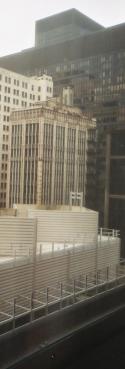
Kyle Kopko
My lunch with Ira Glass is a well-written profile of This American Life's producer, Ira Glass by Rachelle Louise Snyder. She manages to tie everything back to the food experience, and the lunch provides a great jumping-off point for an interesting discussion of Ira's life and work.
Here are a few of the methods she employs...
During the lunch, Ira says something that is representative of his writing style...
Although Snyder quotes this statement, she doesn't draw attention to it at first. It fulflis an ordinary purpose in the narrative flow, telling us us why Ira likes the restaurant. The quote passes, and other things happen. But later on, during a discussion of Ira's style and interests, she brings it in again...
Glass is a writer's writer, or more aptly a writer's radio host. He understands how narrative works, how to build tension, how to place words within sentences and sentences within paragraphs, how at the end of a story a character must be transformed. Every good writer knows that the most important, most evocative information should come at the end of a sentence or paragraph, and even in conversation he does this. Take his earlier words, for example: "They've chosen, as their medium, food. I love that." He doesn't say: "I love that they've chosen food as their medium." Because he knows -- probably instinctively -- that what comes last will carry the most weight; he knows where inside a sentence the power lies -- or rather where inside a sentence lies the power. And so even in his speech you hear the pregnant pauses, the places where, if he were writing the conversation, he would use colons, semicolons and dashes.
Brilliant. By introducing the idea first and reflecting on it later, she reproduces the process of discovery for the reader. Snyder also picks up on a great symbolic detail/metaphor that works three ways. First, she quotes Glass
By including the quote, Snyder gives us a scene at the table over the food. She tells us what she ate. But she also shows us more of Glass's quirky style. The whole article illustrates Glass's show as a combination of interesting stories, deeper meaning, and artistry. Then, in the last paragraph, Snyder ties everything together: the show, the man, and the food:

